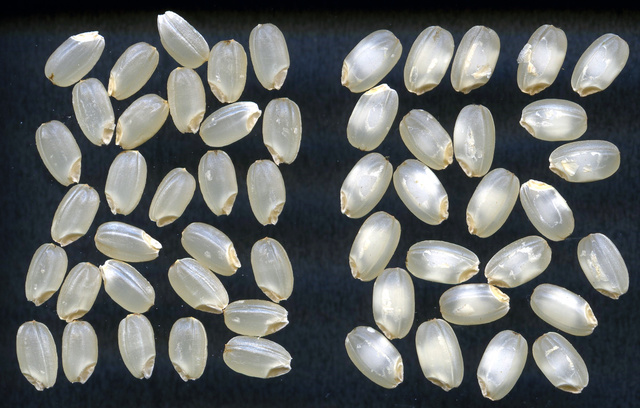Rice plays a central role in sake brewing, serving as both the foundation and the star ingredient. However, not all rice is created equal when it comes to brewing. The journey from grain to glass highlights how specific types of rice are carefully selected and treated to create sake with distinct flavors and character.
What Makes Sake Rice Special?
In sake brewing, brewers use a unique type of rice called sakamai (酒造好適米, sake brewing rice), which differs significantly from the table rice commonly consumed in everyday meals. Sakamai is carefully cultivated to enhance qualities essential for sake production.
Key Characteristics of Sakamai:
- Shinpaku (心白): The soft, starchy core in the center of the rice grain, which aids fermentation.
- Senryu-jū (千粒重): Indicates the weight of a thousand grains, reflecting size and density.
- High Water Absorption: Sakamai has an excellent capacity to absorb water, making it ideal for steaming and fermentation.
- Low Protein Content: Lower levels of protein and fats contribute to a cleaner flavor, allowing the delicate nuances of sake to shine through.
- Firm Outer Layer, Soft Interior After Steaming: This structure allows brewers to manage the fermentation process more effectively, resulting in refined flavor profiles.
These features of sake rice make it highly suitable for brewing, as they directly influence the texture and flavor of the final product.

Sake Rice vs. Table Rice
Sake rice and table rice may belong to the same species, but their uses and cultivation differ significantly. Table rice, used in daily meals, is grown primarily for flavor and nutritional value. In contrast, sake rice is bred specifically for brewing, with particular attention to its physical properties, such as grain size and the proportion of shinpaku.
Although some sake is brewed using table rice, achieving the same level of quality and complexity is more challenging. The lack of a well-developed shinpaku in table rice, for instance, makes it harder for brewers to control the fermentation process. Still, some brewers are experimenting with table rice to create unique sakes that push the boundaries of traditional brewing.
Renowned Varieties of Sake Rice
Certain varieties of sake rice are well-known for their superior brewing qualities, each contributing a distinct character to the sake.
- Yamada Nishiki (山田錦): Often referred to as the "king of sake rice," Yamada Nishiki is prized for its large grains and high shinpaku content. It produces refined, aromatic sakes with a smooth texture.
- Gohyakumangoku (五百万石): This variety is known for its light flavor profile and is often used in crisp, dry sakes. Its grains are slightly smaller, but they absorb water well, making it ideal for brewing clean, refreshing sakes.
- Omachi (雄町): With a rich history dating back over a century, Omachi rice produces robust, full-bodied sakes. It’s known for creating more complex and earthy flavor profiles, making it a favorite among sake enthusiasts.
The Importance of Polishing
The degree of rice polishing, known as seimaibuai (精米歩合), plays a crucial role in determining the flavor and quality of sake. Polishing removes the outer layers of the rice grain, which contain fats and proteins, leaving behind the starchy core (shinpaku) that is most suitable for fermentation.
- High Polishing Ratios: For premium sakes, such as daiginjo (大吟醸), the rice is polished down to 50% or less of its original size. This results in delicate, aromatic sakes with a clean, elegant finish.
- Lower Polishing Ratios: Sakes with a lower degree of polishing, like junmai (純米), tend to have a richer, more full-bodied flavor, as more of the rice grain’s outer layer remains intact.

How Sake Rice Shapes the Brewer’s Craft
While the choice of rice is crucial, the brewer’s skill in harnessing its potential is equally important. The properties of sake rice allow brewers to control factors like fermentation time and temperature with precision, which in turn influences the sake’s flavor, aroma, and texture. Brewers often experiment with different rice varieties and polishing ratios to craft unique expressions of sake.
Modern breweries are pushing the boundaries by experimenting with table rice instead of traditional sake rice. Although the process is more difficult, these brewers have managed to produce exceptional sakes that rival, and sometimes even surpass, those made with sake rice. This trend highlights the brewer’s dedication and creativity in the brewing process.
Sake Rice and the Drinking Experience
When enjoying sake, paying attention to the type of rice used can enhance your appreciation of the drink. Sakes made with high-quality sake rice like Yamada Nishiki or Gohyakumangoku often exhibit nuanced flavors that reflect the craftsmanship behind each bottle.
Breweries are increasingly focusing on sustainability and innovation in rice cultivation to maintain the quality and availability of sakamai. Challenges such as climate change and the need for sustainable farming practices are driving new research and development in sake rice varieties. Additionally, advancements in brewing technology are allowing brewers to better utilize the unique properties of sakamai, resulting in more consistent and high-quality sakes.

From Grain to Glass
Rice is more than just an ingredient in sake—it’s the foundation upon which the entire brewing process is built. Whether it’s the finely polished grains of Yamada Nishiki or the experimentation with table rice, each bottle of sake carries with it the story of its grain. By understanding the unique role of sake rice, you can deepen your appreciation for this traditional Japanese beverage and the craft behind it.
- Rice Selection Matters: Opt for sakes made with renowned sake rice varieties for a superior taste experience.
- Explore Diverse Flavors: Different rice types offer unique flavor profiles, enhancing your sake-tasting journey.
- Support Craft Brewers: Choose breweries that emphasize quality rice and innovative brewing practices to enjoy exceptional sakes.
The ongoing efforts to innovate and preserve the quality of sake rice ensure that sake remains a dynamic and evolving tradition. As brewers continue to explore new techniques and rice varieties, the future of sake brewing promises exciting developments for enthusiasts and newcomers alike.
